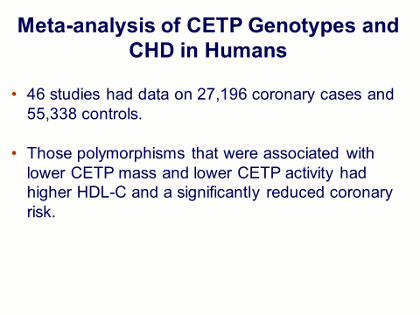Barter - Figure 10 - CETP genotypes Text
What about the activities of CETP in humans? Evidence from individual studies has been quite inconsistent, but looking at genetics, the results of a recent meta-analysis[15] of CETP genotypes in relation to CHD found 46 studies with data from >27,000 coronary cases and >55,000 controls.
As summarized in the Figure, the analysis found that those polymorphisms that were associated with lower CETP mass and lower CETP activity had higher HDL levels and a significantly reduced CHD risk. What was really important, however, was that the reduction in risk was what would have been predicted from the increase in HDL levels. In other words, this result is not absolutely consistent with the CETP inhibition hypothesis, but the result is nevertheless very encouraging that we are on the right track.
J Clin Lipidol. 2011; 5(6).References
[15]Thompson A, DeAngelantonio E, Sarwar N, et al. Association of Cholesteryl Ester Transfer Protein Genotypes With CETP Mass and Activity, Lipid Levels, and Coronary Risk. JAMA 2008; 299: 2777-2788.
